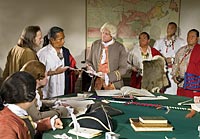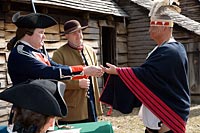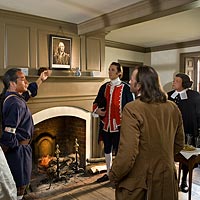“A Principal Source of Dishonor”:
Indian Policies in Early America
by Jack Lynch

Bill Weldon as Governor Fauquier, center, and his council negotiate with the Cherokee, here from left, Ernest “Beaver” Grant, Eddie Swimmer, Keith Anderson, and Nick Moore.

Michael Wells, Travis Henline and Gregory Hunt from a scene in the electronic field trip “Emmissaries of Peace.”

A reenactment of the viewing of King George’s portrait at the Bray School in Williamsburg for the electronic field trip “Emmissaries of Peace.”
They were there from the beginning—from before the beginning. We have long begun our national story with Christopher Columbus's discovery of the Americas, but the very first thing Columbus described after his landing was an encounter with the Native Americans who already lived here. As he put it in 1493, "I discovered a great many islands, inhabited by numberless people." Too often, those numberless people are overlooked, but Native Americans have been part of the American story for as long as there has been an American story.
Reliable numbers are hard to come by, but all the estimates show a sharp decline in Indian population after the arrival of Europeans. Historian William Denevan estimates the North American population in 1492 at 3.8 million; by 1800, Indians numbered one million—a 74 percent decline. It is too easy, though, to turn a story of broken treaties, military aggression, bad faith, and infectious disease into a tale of individual acts. It may be more productive to understand it as a series of well-intentioned policies gone wrong.
In the seventeenth century, European settlers began negotiating with the Indians for territory. These negotiations were usually piecemeal: individuals, companies, and townships worked out their own deals with the locals. This patchwork of agreements caused confusion. There was no central organization to keep track of the deals. Some did not care about negotiations, and took by force what had been disposed by treaty.
In the eighteenth century, improvised agreements gave way to a coherent set of colonial strategies. In the first attempt at such a policy, the Proclamation of 1763, George III decreed:
The several Nations or tribes of Indians with whom We are connected . . . should not be molested or disturbed in the Possession of such Parts of our Dominions and Territories as, not having been ceded to or purchased by Us, are reserved to them . . . as their Hunting Grounds.
He drew a line along the Alleghenies, and ordered his subjects to remain east of it. By 1768, the surveying was complete from Canada to Florida, and for the first time Indian Country was formally established. There had always been a kind of frontier, but the Proclamation of 1763 made the west officially off-limits.
George Washington, and others, could "never look upon that Proclamation in any other light, than as a temporary expedient to quiet minds of the Indians." He knew that ever-increasing numbers of European Americans would move west despite it: the urge to expand was irresistible.
This pattern—with the central government working to restrict westward expansion, and the people eager to move west quickly—marked relations with the Indians during the next hundred years.
The Revolutionary War complicated matters. Benjamin Franklin and Patrick Henry urged the Indians to remain neutral, with little success. Some tribes sided with the British; some supported the rebels; some stayed neutral. Others were divided.
As the war ended, all this complexity was forgotten. In the minds of most citizens of the newly independent United States, the Indians had supported Great Britain; as allies of a conquered power, they should expect to be treated as such. The Treaty of Paris, which ended the war in 1783, recognized the United States' claims to American territory.
Washington summarized, in a letter of 1783, the prevailing American attitude:
The Indians should be informed, that after a Contest of eight years for the Sovereignty of this Country G: Britain has ceded all the Lands of the United States within the limits discribed by . . . the Provisional Treaty.
Many tribes were astonished to discover that a foreign treaty composed without their consent or consultation was distributing their land.
When the new United States found itself responsible for Indian policy, its citizens often continued to view the Native Americans as defeated enemies. It is telling that in 1789, the Congress gave authority for Indian relations to a division of the War Department. Nevertheless, whites realized that perpetual war could not be sustained.
They were soon taught the lessons that George III had learned decades earlier: that a patchwork of agreements with the Indian tribes could only lead to strife. The Framers therefore wrote into the Constitution a provision that gave Congress the sole power "to regulate Commerce . . . with the Indian Tribes." President Washington, who had been skeptical about George III's Indian policies in the 1760s, found himself proposing and enforcing similar policies.
In 1790, Congress passed the Act to Regulate Trade and Intercourse with the Indian Tribes, the first federal law on the subject. "No person," the law said, "shall be permitted to carry on any trade or intercourse with the Indian tribes, without a license for that purpose." The United States, though, was no more successful at managing an orderly westward expansion than Britain had been. Washington's third annual address, in 1791, said that these "measures having proved unsuccessful, it became necessary to convince the refractory of the power of the United States to punish their depredations." He offered proposals to keep citizens out of Indian territory, but the same problems that rendered the Proclamation of 1763 a mere "temporary expedient" plagued his own attempts to manage the frontier.
It was the third president, Thomas Jefferson, who showed most clearly the conflicted Euro-American conceptions of Native Americans. Historian Anthony F. C. Wallace wrote: "Jefferson appears both as the scholarly admirer of Indian character, archaeology, and language and as the planner of cultural genocide, the architect of the removal policy, the surveyor of the Trail of Tears."
That neatly embodies early American attitudes toward "primitive" peoples. The age of empire brought Europeans into contact with an unprecedented number of people they had never seen before, which forced them to rethink what it meant to be human. As too often happens when people are confronted with new experiences, they tried to make sense of them by means of myths, and two myths stood out above all others.
On the one hand, the Native Americans were the inhuman, bloodthirsty, and merciless barbarians who delighted in murdering white babies in their cribs. As Michel de Montaigne put it late in the sixteenth century, "Every one gives the Title of Barbarity to every Thing that is not in use in his own Country." On the other hand, the Natives were noble savages living in balance with nature, uncorrupted by European civilization, preserving their ancient purity and goodness. The eighteenth century, fascinated with "man in the state of nature," could romanticize him just as easily as it could turn him into a monster.
Jefferson, like many in his day, maintained both attitudes at once. He later told friends, "Before the Revolution, the Indians were in the habit of coming often and in great numbers to the seat of government" in Williamsburg, "where I was very much with them." There "the great Outacite, the warrior and orator of the Cherokees," who stopped in Virginia's capital on the way to England, impressed him. Jefferson praised his farewell oration to his people the evening before his departure:
The moon was in full splendor, and to her he seemed to address himself in his prayers for his own safety on the voyage, and that of his people during his absence; his sounding voice, distinct articulation, animated actions, and the solemn silence of his people at their several fires, filled me with awe and veneration.
A similar awe marked his account of "Logan's Lament," the speech of an Indian whose family was murdered by whites, leading to Logan's revenge and the start of Dunmore's War in 1774. As Jefferson recorded it, Logan said:
I appeal to any white man to say, if ever he entered Logan's cabin hungry, and he gave him not meat; if ever he came cold and naked, and he clothed him not. During the course of the last long and bloody war, Logan remained idle in his cabin, an advocate for peace. Such was my love for the whites, that my countrymen pointed as they passed, and said, "Logan is the friend of white men." I had even thought to have lived with you, but for the injuries of one man. Col. Cresap, the last spring, in cold blood, and unprovoked, murdered all the relations of Logan, not sparing even my women and children. There runs not a drop of my blood in the veins of any living creature. This called on me for revenge. I have sought it: I have killed many: I have fully glutted my vengeance. For my country, I rejoice at the beams of peace. But do not harbour a thought that mine is the joy of fear. Logan never felt fear. He will not turn on his heel to save his life. Who is there to mourn for Logan?—Not one.
Jefferson said, "I may challenge the whole orations of Demosthenes and Cicero . . . to produce a single passage, superior to the speech." He reproduced it in Notes on the State of Virginia, and it was memorized by generations of schoolchildren.
Yet Jefferson never learned how to deal with the Indians as equals; for him they were children who had to be taken by the hand. He was typical of his age, arguing that "all humankind had passed through savagery and barbarism before gaining civilization," and he saw it as his responsibility to guide the Indians, whether or not they were willing to be led. Throughout his career, he expressed admirable sentiments about protecting them from white incursions. As early as 1786 he found American treatment of the Indians "a principal source of dishonor to the American character," and found it only natural that "after the injuries we have done them, they cannot love us." He was convinced that this state of affairs "leaves us no alternative but that of fear to keep them from attacking us."
In 1803 he said he hoped "to live in perpetual peace with the Indians, to cultivate an affectionate attachment from them by everything just and liberal which we can do for them," and his Second Inaugural Address, in 1805, included a section on "The aboriginal inhabitants of these countries," whom he had "regarded with the commiseration their history inspires." The Indians, he said, "have been overwhelmed by the current or driven before it." But he was part of that current. So confident was he in the superiority of European civilization to Indian culture that he said:
Humanity enjoins us to teach them agriculture and the domestic arts, to encourage them to that industry which alone can enable them to maintain their place in existence and to prepare them in time for that state of society which to bodily comforts adds the improvement of the mind and morals.
What, though, if they were not willing to learn from whites, or have their minds and morals improved? Jefferson said they must be removed from American territory. The term "reservation," which had long meant "something set aside," acquired a new sense in a congressional debate of 1789.
Because of his conviction that European society was inherently superior to anything Native Americans had achieved, Jefferson often fell short of the enlightened standard he set for himself. He pressured the Indians either to adopt European habits or to leave—a policy that saw its fullest expression in the Trail of Tears of the 1830s, when tens of thousands of natives were forcibly relocated and thousands died on the way.
Andrew Jackson began the large-scale movement of populations, but it was Jefferson who made it possible with the Louisiana Purchase, and Jefferson who began to plan for resettlement. As Wallace puts it, "There was a degree of ruthlessness in Jefferson's dealings with the native peoples, the ruthlessness of a benevolent zealot who would do virtually anything to ensure that his new, free American republic survived and grew."
He was not above resorting to unfair dealing, bribing influential chiefs, threatening embargoes, running the natives into debt and forcing them to cede their land. Jefferson, writes Wallace, saw the Indians
as noble but doomed savages, tragically slaughtered in wars precipitated by a few murderous frontiersmen and a few vengeful warriors, a surviving remnant yearning to be civilized but fated to lose their land to a deserving white yeomanry.
Today, two centuries after Jefferson left office, it is difficult to talk about Native Americans without falling back on the same stereotypes. We are heirs to the eighteenth-century obsession with the state of nature. We have never found a fully satisfying way to talk about the aboriginal inhabitants of the Americas without resorting to images of murderous savages on the one hand or noble innocents on the other. It is one of the American tragedies that the Native Americans have often found themselves trapped between these two conceptions.
Jack Lynch, author of Becoming Shakespeare: The Unlikely Afterlife That Turned a Provincial Playwright into the Bard (Walker & Co., 2007) is associate professor of English at Rutgers University. He contributed to the winter 2009 journal a story about the Bill of Rights.
Suggestions for further reading:
- Robert F. Berkhofer, Jr., The White Man's Indian: Images of the American Indian from Columbus to the Present (New York, 1978).
- William M. Denevan, "The Pristine Myth: The Landscape of the Americas in 1492," Annals of the Association of American Geographers 82, no. 3 (Sept. 1992): 369–85.
- Frederick E. Hoxie, Ronald Hoffman, and Peter J. Albert, eds., Native Americans and the Early Republic (Charlottesville, VA, 1999).
- Roy Harvey Pearce, Savagism and Civilization: A Study of the Indian and the American Mind, rev. ed. (Berkeley, CA, 1988).
- Francis Paul Prucha, American Indian Policy in the Formative Years: The Indian Trade and Intercourse Acts, 1790–1834 (Cambridge, MA, 1962).
- Anthony F. C. Wallace, Jefferson and the Indians: The Tragic Fate of the First Americans (Cambridge, MA, 1999).
